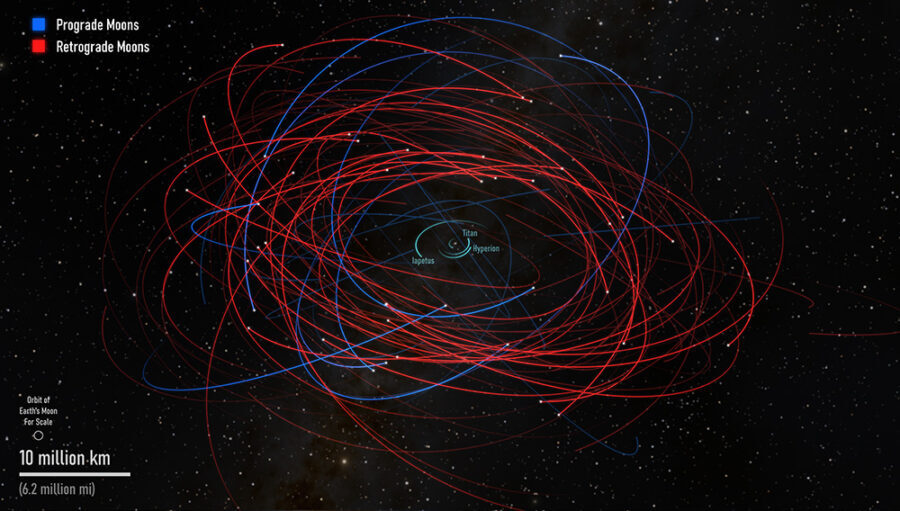
As of press time, the Minor Planet Center (MPC) has published the orbits of 41 new moons in a series of announcements, called Minor Planet Electronic Circulars, issued between May 3rd and 10th. Brett Gladman (University of British Columbia, Canada) said May 11th that the center would release orbits for an additional 21 moons shortly. That will bring Saturn's total moon count to 145, including 24 "regular" moons, which formed around the planet, and 121 smaller, "irregular" moons on wide, elongated, and tilted orbits. The new reports more than double Saturn's number of irregular moons, leaving Saturn far ahead of Jupiter's 95 moons, which had put Jupiter in first place earlier this year.
The torrent of Saturnian discoveries comes from a series of observations that Edward Ashton (now at Academia Sinica Institute of Astronomy and Astrophysics, Taiwan) and colleagues, including Gladman, made with the Canada France Hawaii Telescope from 2019 to 2021. Their initial goal was to study the sizes of moons orbiting Saturn, and in 2021 they reported the size distribution of the small irregular moons. The larger amount of smaller moons indicates a recent (100 million years ago) collision between two objects around Saturn. To record faint moons down to a couple kilometers in size, the group stacked series of images, a method used previously to search for moons around Uranus and Neptune, but not previously for Saturn.
The group's next project was to calculate orbits for the objects over the period for which the researchers had obtained observations. The process is laborious but essential and involves tracking the motion of small objects across the sky over time. "Linking [observations of] moons within the same year was fairly straightforward," Ashton says, "but since there were only a few observations per year, linking the moons between different years was very time-consuming and involved a lot of trial and error."
Orbit tracking is difficult. "These moons are far from the planet, their orbits are not trivial closed ones ... and you're seeing them from a moving Earth," Gladman says.
The next step was to take the finds to the MPC. "We have been slowly submitting our observations to the MPC since 2020," says Ashton. The center's archives go back many years. Comparing new discoveries to archived objects is difficult because it requires running orbits backward over many years. At the same time, successfully matching a new object's orbit with older observations improves the accuracy of its orbital parameters.
How many more Saturnian moons remain undiscovered? The 2021 survey covered only 2.2 square degrees of the 26 square degrees of sky in which Saturn's gravity dominates, a region called the Hill sphere. However, irregular moons rarely go more than more than half the radius of the Hill sphere from a planet, Ashton says: "In reality, about 75% of the known moons were in our fields at any one time." In their 2021 paper Ashton and Gladman estimated that Saturn has about 150 irregular moons at least 3 kilometers (2 miles) in diameter. With about 120 such moons now known, Ashton says, "there are about 30 left [undiscovered] in this size range [and] likely many hundreds, if not thousands, of Saturnian moons with smaller sizes."
Fortuitous discoveries of remaining moons are unlikely, says K Ly, an independent citizen scientist who specializes in archival astronomical data. An observer looking for something else would not be likely to recognize a new moon and would instead assume it was an unremarkable asteroid.



It has the capability of producing a flare that would exceed a Carrington style event and disturb Earth's atmosphere.
I speculated its arrival and posted this on SOTT, I did suggest then that it could take 2 Sun rotations to arrive, it will be Earth facing in less than 10 days time.
I would strongly recommend that folk follow its progress.